2012 FORD SUPER DUTY display
[x] Cancel search: displayPage 54 of 93
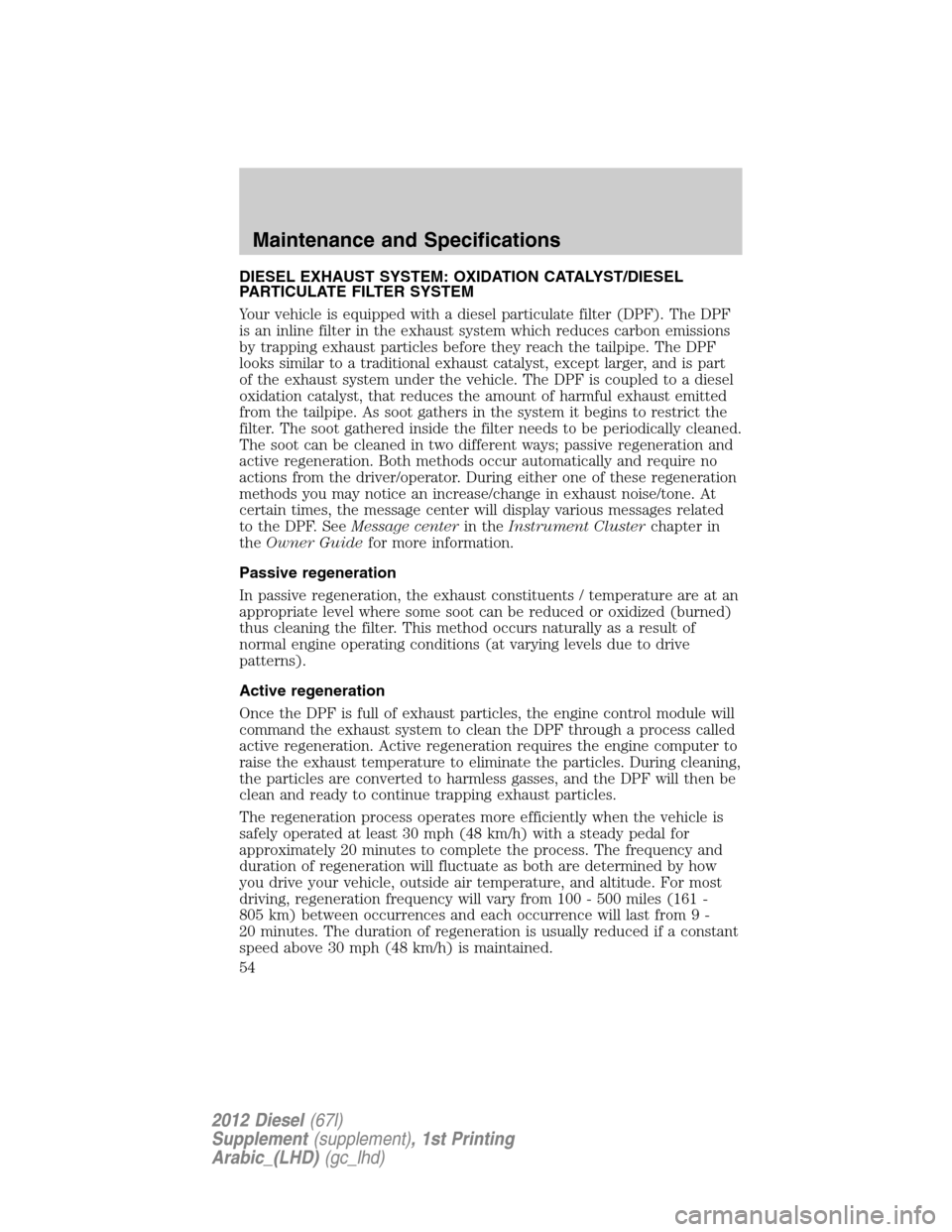
DIESEL EXHAUST SYSTEM: OXIDATION CATALYST/DIESEL
PARTICULATE FILTER SYSTEM
Your vehicle is equipped with a diesel particulate filter (DPF). The DPF
is an inline filter in the exhaust system which reduces carbon emissions
by trapping exhaust particles before they reach the tailpipe. The DPF
looks similar to a traditional exhaust catalyst, except larger, and is part
of the exhaust system under the vehicle. The DPF is coupled to a diesel
oxidation catalyst, that reduces the amount of harmful exhaust emitted
from the tailpipe. As soot gathers in the system it begins to restrict the
filter. The soot gathered inside the filter needs to be periodically cleaned.
The soot can be cleaned in two different ways; passive regeneration and
active regeneration. Both methods occur automatically and require no
actions from the driver/operator. During either one of these regeneration
methods you may notice an increase/change in exhaust noise/tone. At
certain times, the message center will display various messages related
to the DPF. SeeMessage centerin theInstrument Clusterchapter in
theOwner Guidefor more information.
Passive regeneration
In passive regeneration, the exhaust constituents / temperature are at an
appropriate level where some soot can be reduced or oxidized (burned)
thus cleaning the filter. This method occurs naturally as a result of
normal engine operating conditions (at varying levels due to drive
patterns).
Active regeneration
Once the DPF is full of exhaust particles, the engine control module will
command the exhaust system to clean the DPF through a process called
active regeneration. Active regeneration requires the engine computer to
raise the exhaust temperature to eliminate the particles. During cleaning,
the particles are converted to harmless gasses, and the DPF will then be
clean and ready to continue trapping exhaust particles.
The regeneration process operates more efficiently when the vehicle is
safely operated at least 30 mph (48 km/h) with a steady pedal for
approximately 20 minutes to complete the process. The frequency and
duration of regeneration will fluctuate as both are determined by how
you drive your vehicle, outside air temperature, and altitude. For most
driving, regeneration frequency will vary from 100 - 500 miles (161 -
805 km) between occurrences and each occurrence will last from 9 -
20 minutes. The duration of regeneration is usually reduced if a constant
speed above 30 mph (48 km/h) is maintained.
Maintenance and Specifications
54
2012 Diesel(67l)
Supplement(supplement), 1st Printing
Arabic_(LHD)(gc_lhd)
Page 55 of 93
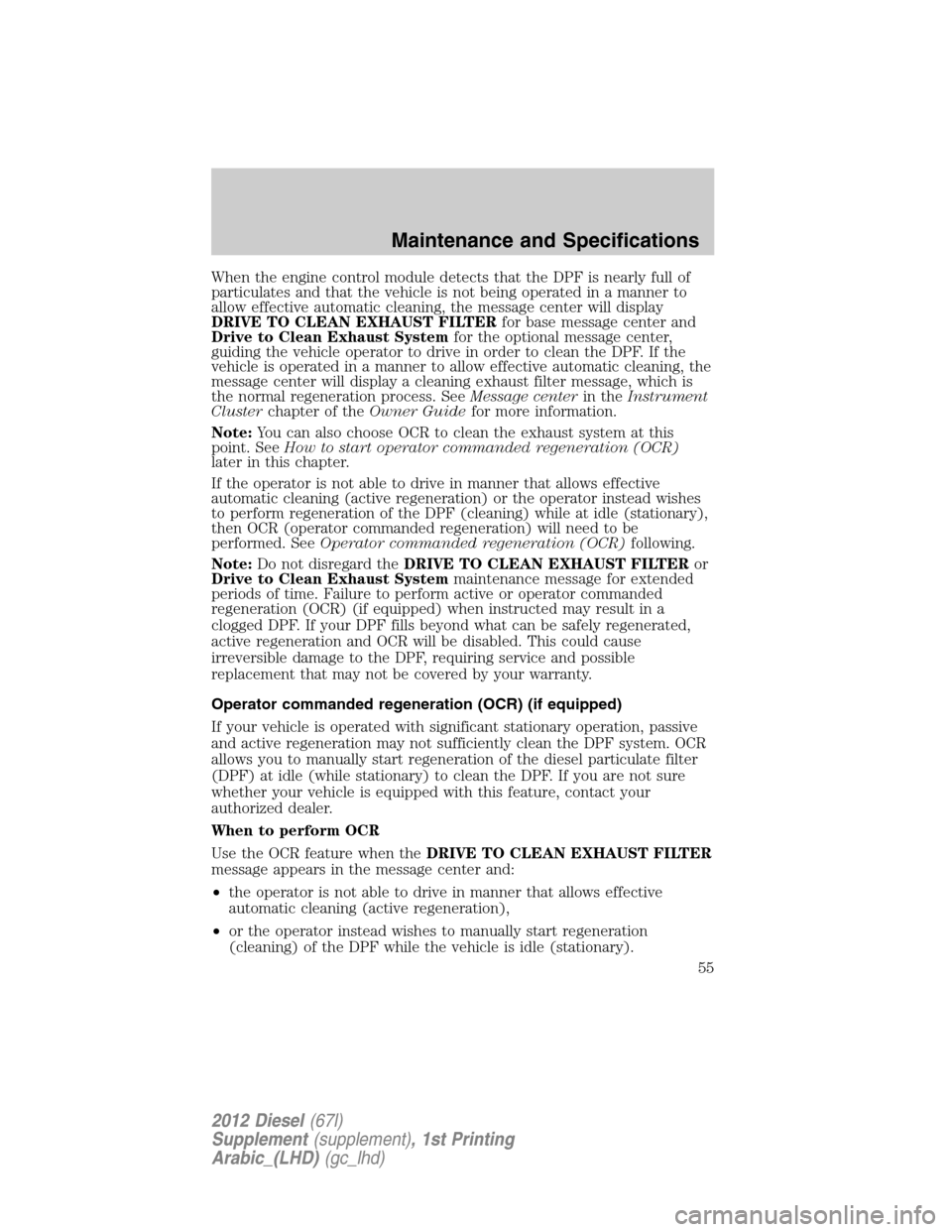
When the engine control module detects that the DPF is nearly full of
particulates and that the vehicle is not being operated in a manner to
allow effective automatic cleaning, the message center will display
DRIVE TO CLEAN EXHAUST FILTERfor base message center and
Drive to Clean Exhaust Systemfor the optional message center,
guiding the vehicle operator to drive in order to clean the DPF. If the
vehicle is operated in a manner to allow effective automatic cleaning, the
message center will display a cleaning exhaust filter message, which is
the normal regeneration process. SeeMessage centerin theInstrument
Clusterchapter of theOwner Guidefor more information.
Note:You can also choose OCR to clean the exhaust system at this
point. SeeHow to start operator commanded regeneration (OCR)
later in this chapter.
If the operator is not able to drive in manner that allows effective
automatic cleaning (active regeneration) or the operator instead wishes
to perform regeneration of the DPF (cleaning) while at idle (stationary),
then OCR (operator commanded regeneration) will need to be
performed. SeeOperator commanded regeneration (OCR)following.
Note:Do not disregard theDRIVE TO CLEAN EXHAUST FILTERor
Drive to Clean Exhaust Systemmaintenance message for extended
periods of time. Failure to perform active or operator commanded
regeneration (OCR) (if equipped) when instructed may result in a
clogged DPF. If your DPF fills beyond what can be safely regenerated,
active regeneration and OCR will be disabled. This could cause
irreversible damage to the DPF, requiring service and possible
replacement that may not be covered by your warranty.
Operator commanded regeneration (OCR) (if equipped)
If your vehicle is operated with significant stationary operation, passive
and active regeneration may not sufficiently clean the DPF system. OCR
allows you to manually start regeneration of the diesel particulate filter
(DPF) at idle (while stationary) to clean the DPF. If you are not sure
whether your vehicle is equipped with this feature, contact your
authorized dealer.
When to perform OCR
Use the OCR feature when theDRIVE TO CLEAN EXHAUST FILTER
message appears in the message center and:
•the operator is not able to drive in manner that allows effective
automatic cleaning (active regeneration),
•or the operator instead wishes to manually start regeneration
(cleaning) of the DPF while the vehicle is idle (stationary).
Maintenance and Specifications
55
2012 Diesel(67l)
Supplement(supplement), 1st Printing
Arabic_(LHD)(gc_lhd)
Page 57 of 93
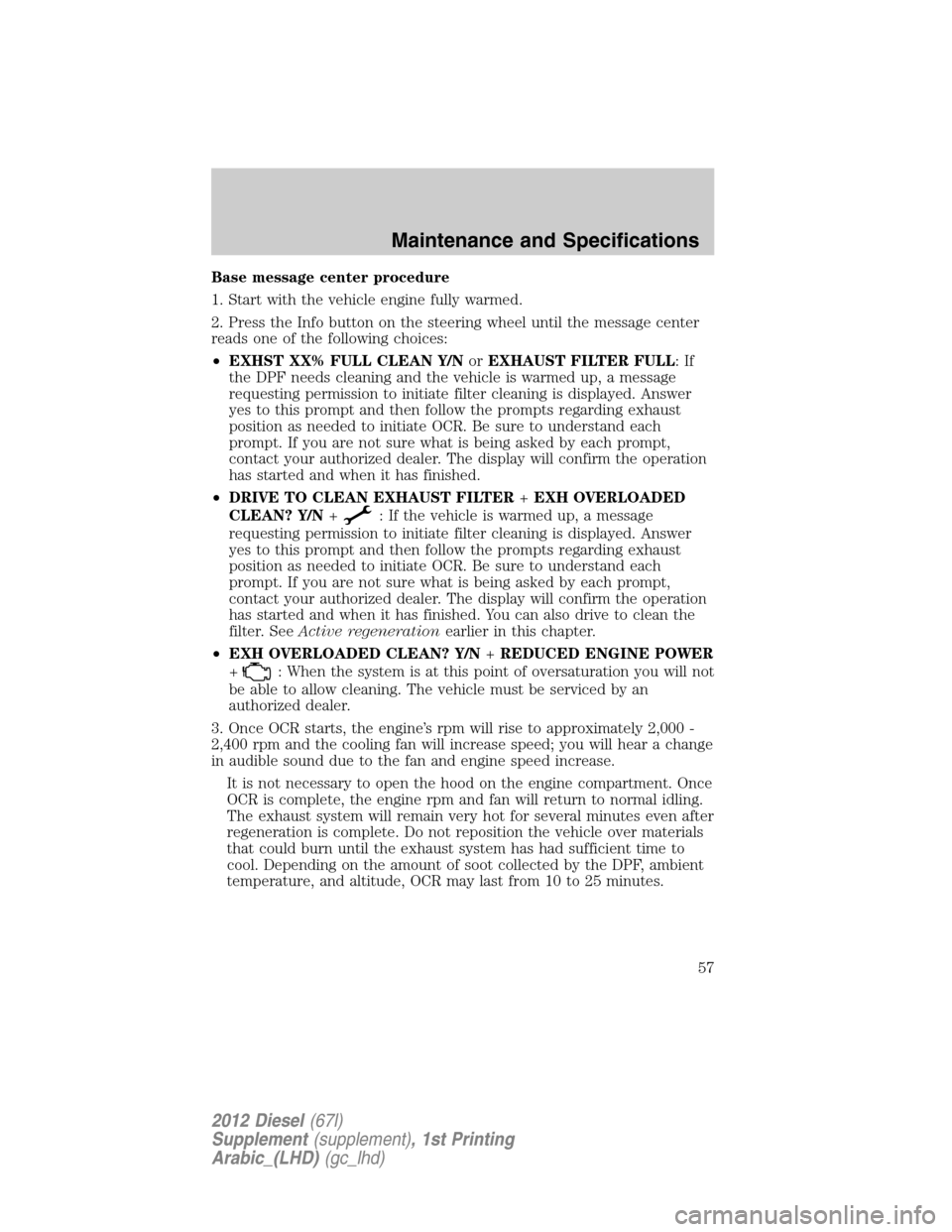
Base message center procedure
1. Start with the vehicle engine fully warmed.
2. Press the Info button on the steering wheel until the message center
reads one of the following choices:
•EXHST XX% FULL CLEAN Y/NorEXHAUST FILTER FULL:If
the DPF needs cleaning and the vehicle is warmed up, a message
requesting permission to initiate filter cleaning is displayed. Answer
yes to this prompt and then follow the prompts regarding exhaust
position as needed to initiate OCR. Be sure to understand each
prompt. If you are not sure what is being asked by each prompt,
contact your authorized dealer. The display will confirm the operation
has started and when it has finished.
•DRIVE TO CLEAN EXHAUST FILTER+EXH OVERLOADED
CLEAN? Y/N+
: If the vehicle is warmed up, a message
requesting permission to initiate filter cleaning is displayed. Answer
yes to this prompt and then follow the prompts regarding exhaust
position as needed to initiate OCR. Be sure to understand each
prompt. If you are not sure what is being asked by each prompt,
contact your authorized dealer. The display will confirm the operation
has started and when it has finished. You can also drive to clean the
filter. SeeActive regenerationearlier in this chapter.
•EXH OVERLOADED CLEAN? Y/N+REDUCED ENGINE POWER
+
: When the system is at this point of oversaturation you will not
be able to allow cleaning. The vehicle must be serviced by an
authorized dealer.
3. Once OCR starts, the engine’s rpm will rise to approximately 2,000 -
2,400 rpm and the cooling fan will increase speed; you will hear a change
in audible sound due to the fan and engine speed increase.
It is not necessary to open the hood on the engine compartment. Once
OCR is complete, the engine rpm and fan will return to normal idling.
The exhaust system will remain very hot for several minutes even after
regeneration is complete. Do not reposition the vehicle over materials
that could burn until the exhaust system has had sufficient time to
cool. Depending on the amount of soot collected by the DPF, ambient
temperature, and altitude, OCR may last from 10 to 25 minutes.
Maintenance and Specifications
57
2012 Diesel(67l)
Supplement(supplement), 1st Printing
Arabic_(LHD)(gc_lhd)
Page 58 of 93
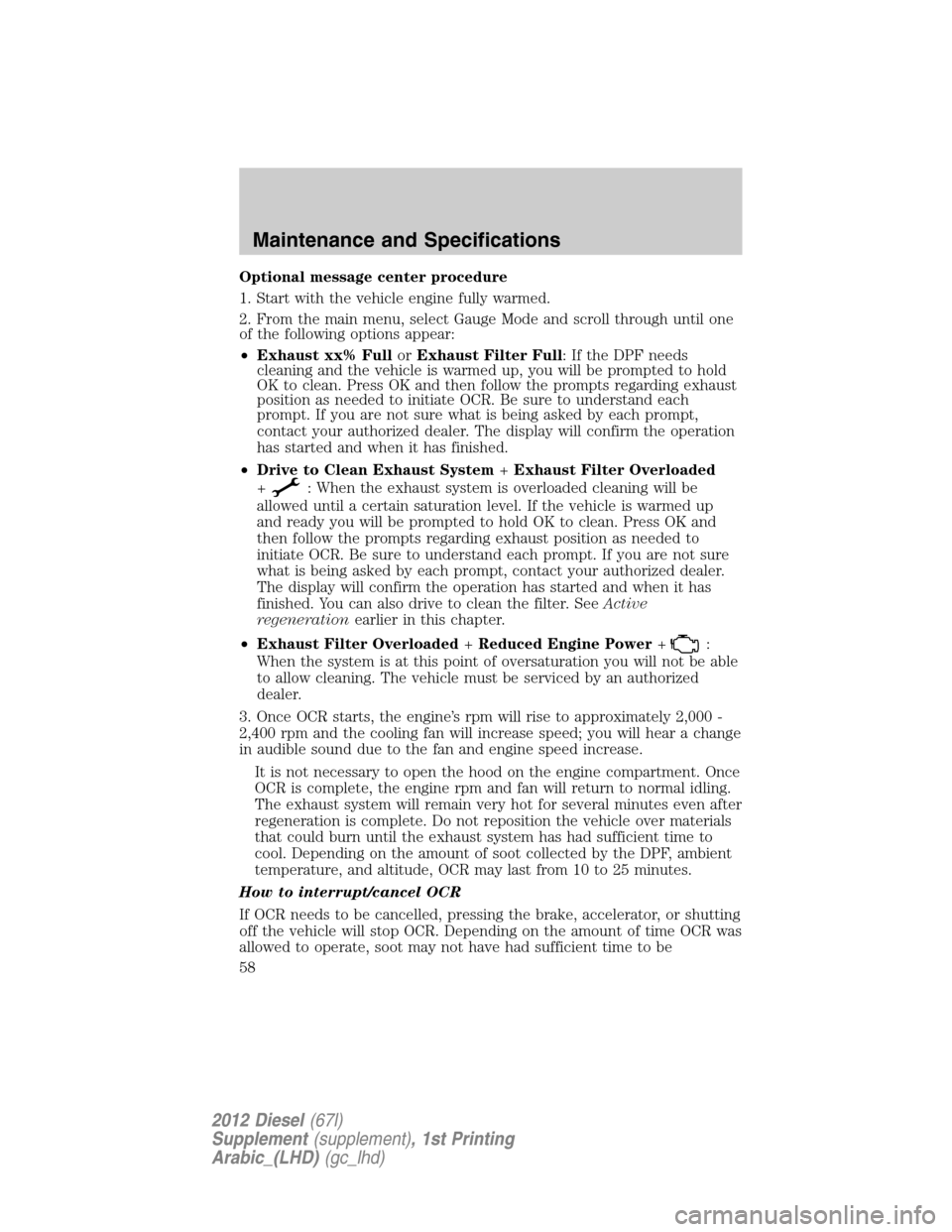
Optional message center procedure
1. Start with the vehicle engine fully warmed.
2. From the main menu, select Gauge Mode and scroll through until one
of the following options appear:
•Exhaust xx% FullorExhaust Filter Full: If the DPF needs
cleaning and the vehicle is warmed up, you will be prompted to hold
OK to clean. Press OK and then follow the prompts regarding exhaust
position as needed to initiate OCR. Be sure to understand each
prompt. If you are not sure what is being asked by each prompt,
contact your authorized dealer. The display will confirm the operation
has started and when it has finished.
•Drive to Clean Exhaust System+Exhaust Filter Overloaded
+
: When the exhaust system is overloaded cleaning will be
allowed until a certain saturation level. If the vehicle is warmed up
and ready you will be prompted to hold OK to clean. Press OK and
then follow the prompts regarding exhaust position as needed to
initiate OCR. Be sure to understand each prompt. If you are not sure
what is being asked by each prompt, contact your authorized dealer.
The display will confirm the operation has started and when it has
finished. You can also drive to clean the filter. SeeActive
regenerationearlier in this chapter.
•Exhaust Filter Overloaded+Reduced Engine Power+
:
When the system is at this point of oversaturation you will not be able
to allow cleaning. The vehicle must be serviced by an authorized
dealer.
3. Once OCR starts, the engine’s rpm will rise to approximately 2,000 -
2,400 rpm and the cooling fan will increase speed; you will hear a change
in audible sound due to the fan and engine speed increase.
It is not necessary to open the hood on the engine compartment. Once
OCR is complete, the engine rpm and fan will return to normal idling.
The exhaust system will remain very hot for several minutes even after
regeneration is complete. Do not reposition the vehicle over materials
that could burn until the exhaust system has had sufficient time to
cool. Depending on the amount of soot collected by the DPF, ambient
temperature, and altitude, OCR may last from 10 to 25 minutes.
How to interrupt/cancel OCR
If OCR needs to be cancelled, pressing the brake, accelerator, or shutting
off the vehicle will stop OCR. Depending on the amount of time OCR was
allowed to operate, soot may not have had sufficient time to be
Maintenance and Specifications
58
2012 Diesel(67l)
Supplement(supplement), 1st Printing
Arabic_(LHD)(gc_lhd)
Page 68 of 93
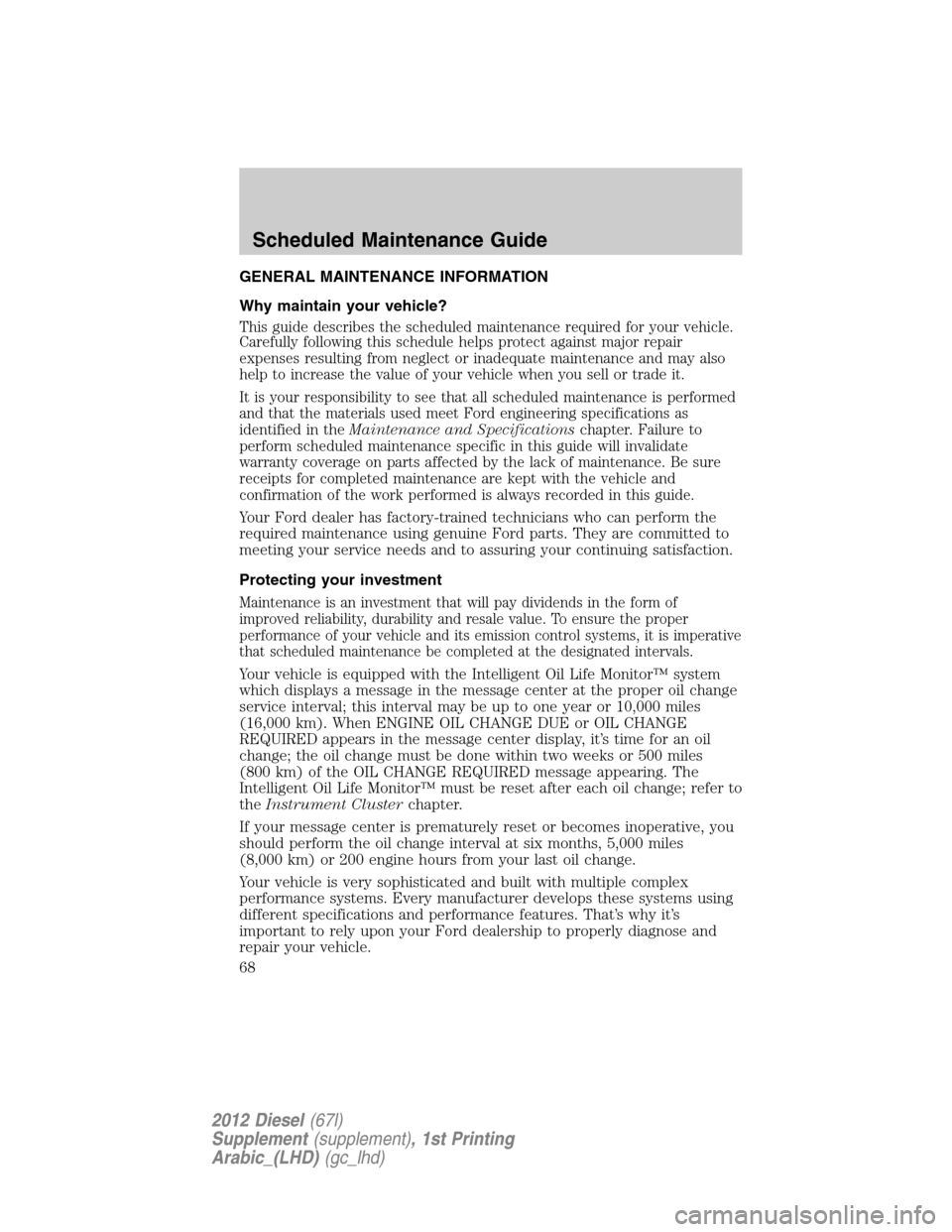
GENERAL MAINTENANCE INFORMATION
Why maintain your vehicle?
This guide describes the scheduled maintenance required for your vehicle.
Carefully following this schedule helps protect against major repair
expenses resulting from neglect or inadequate maintenance and may also
help to increase the value of your vehicle when you sell or trade it.
It is your responsibility to see that all scheduled maintenance is performed
and that the materials used meet Ford engineering specifications as
identified in theMaintenance and Specificationschapter. Failure to
perform scheduled maintenance specific in this guide will invalidate
warranty coverage on parts affected by the lack of maintenance. Be sure
receipts for completed maintenance are kept with the vehicle and
confirmation of the work performed is always recorded in this guide.
Your Ford dealer has factory-trained technicians who can perform the
required maintenance using genuine Ford parts. They are committed to
meeting your service needs and to assuring your continuing satisfaction.
Protecting your investment
Maintenance is an investment that will pay dividends in the form of
improved reliability, durability and resale value. To ensure the proper
performance of your vehicle and its emission control systems, it is imperative
that scheduled maintenance be completed at the designated intervals.
Your vehicle is equipped with the Intelligent Oil Life Monitor™ system
which displays a message in the message center at the proper oil change
service interval; this interval may be up to one year or 10,000 miles
(16,000 km). When ENGINE OIL CHANGE DUE or OIL CHANGE
REQUIRED appears in the message center display, it’s time for an oil
change; the oil change must be done within two weeks or 500 miles
(800 km) of the OIL CHANGE REQUIRED message appearing. The
Intelligent Oil Life Monitor™ must be reset after each oil change; refer to
theInstrument Clusterchapter.
If your message center is prematurely reset or becomes inoperative, you
should perform the oil change interval at six months, 5,000 miles
(8,000 km) or 200 engine hours from your last oil change.
Your vehicle is very sophisticated and built with multiple complex
performance systems. Every manufacturer develops these systems using
different specifications and performance features. That’s why it’s
important to rely upon your Ford dealership to properly diagnose and
repair your vehicle.
Scheduled Maintenance Guide
68
2012 Diesel(67l)
Supplement(supplement), 1st Printing
Arabic_(LHD)(gc_lhd)
Page 73 of 93
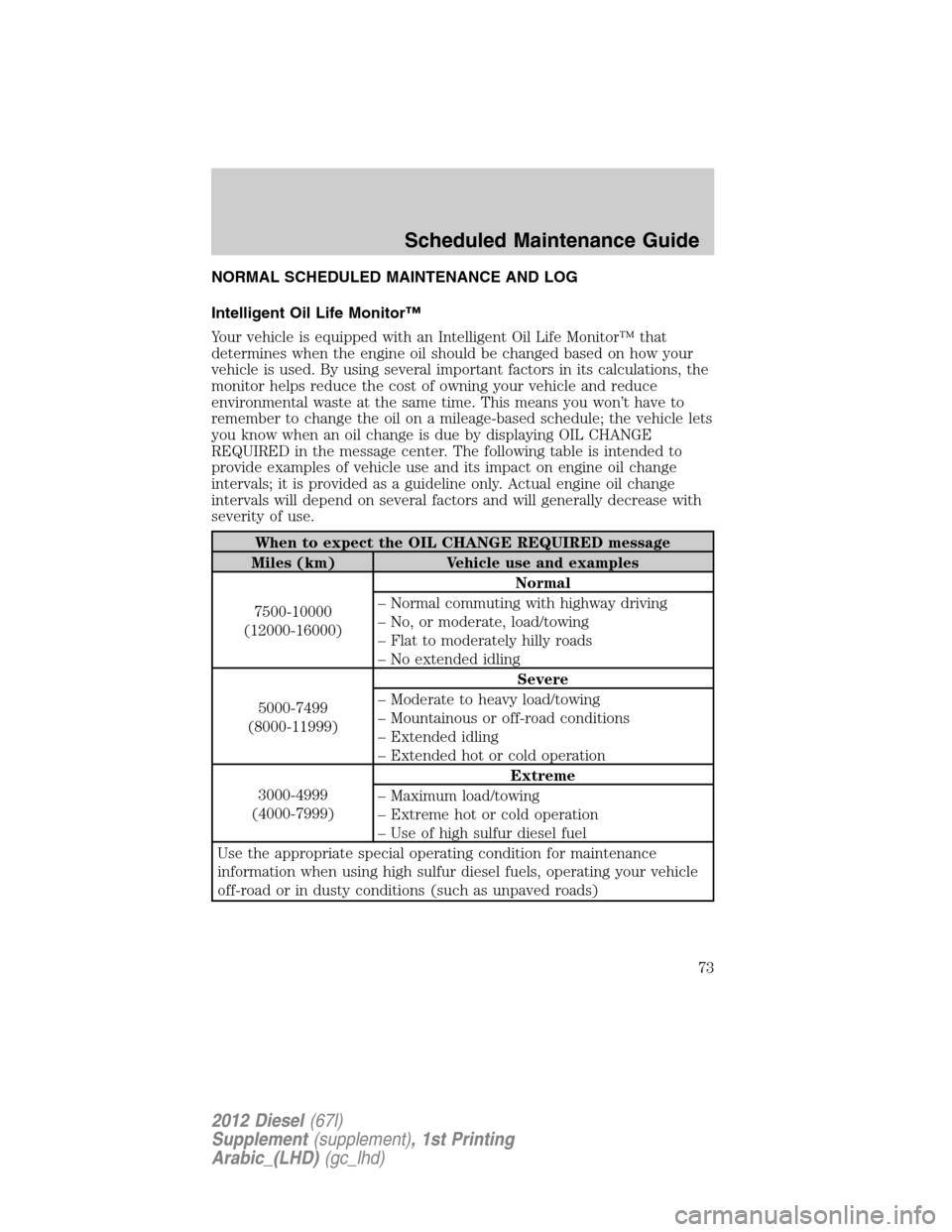
NORMAL SCHEDULED MAINTENANCE AND LOG
Intelligent Oil Life Monitor™
Your vehicle is equipped with an Intelligent Oil Life Monitor™ that
determines when the engine oil should be changed based on how your
vehicle is used. By using several important factors in its calculations, the
monitor helps reduce the cost of owning your vehicle and reduce
environmental waste at the same time. This means you won’t have to
remember to change the oil on a mileage-based schedule; the vehicle lets
you know when an oil change is due by displaying OIL CHANGE
REQUIRED in the message center. The following table is intended to
provide examples of vehicle use and its impact on engine oil change
intervals; it is provided as a guideline only. Actual engine oil change
intervals will depend on several factors and will generally decrease with
severity of use.
When to expect the OIL CHANGE REQUIRED message
Miles (km) Vehicle use and examples
7500-10000
(12000-16000)Normal
– Normal commuting with highway driving
– No, or moderate, load/towing
– Flat to moderately hilly roads
– No extended idling
5000-7499
(8000-11999)Severe
– Moderate to heavy load/towing
– Mountainous or off-road conditions
– Extended idling
– Extended hot or cold operation
3000-4999
(4000-7999)Extreme
– Maximum load/towing
– Extreme hot or cold operation
– Use of high sulfur diesel fuel
Use the appropriate special operating condition for maintenance
information when using high sulfur diesel fuels, operating your vehicle
off-road or in dusty conditions (such as unpaved roads)
Scheduled Maintenance Guide
73
2012 Diesel(67l)
Supplement(supplement), 1st Printing
Arabic_(LHD)(gc_lhd)